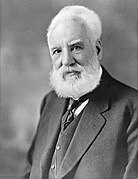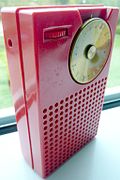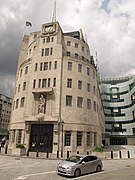Portal:Telecommunication

Telecommunication, often used in its plural form or abbreviated as telecom, is the transmission of information with an immediacy comparable to face-to-face communication. As such, slow communications technologies like postal mail and pneumatic tubes are excluded from the definition. Many transmission media have been used for telecommunications throughout history, from smoke signals, beacons, semaphore telegraphs, signal flags, and optical heliographs to wires and empty space made to carry electromagnetic signals. These paths of transmission may be divided into communication channels for multiplexing, allowing for a single medium to transmit several concurrent communication sessions. Several methods of long-distance communication before the modern era used sounds like coded drumbeats, the blowing of horns, and whistles. Long-distance technologies invented during the 20th and 21st centuries generally use electric power, and include the telegraph, telephone, television, and radio.
Early telecommunication networks used metal wires as the medium for transmitting signals. These networks were used for telegraphy and telephony for many decades. In the first decade of the 20th century, a revolution in wireless communication began with breakthroughs including those made in radio communications by Guglielmo Marconi, who won the 1909 Nobel Prize in Physics. Other early pioneers in electrical and electronic telecommunications include co-inventors of the telegraph Charles Wheatstone and Samuel Morse, numerous inventors and developers of the telephone including Antonio Meucci and Alexander Graham Bell, inventors of radio Edwin Armstrong and Lee de Forest, as well as inventors of television like Vladimir K. Zworykin, John Logie Baird and Philo Farnsworth.
Since the 1960s, the proliferation of digital technologies has meant that voice communications have gradually been supplemented by data. The physical limitations of metallic media prompted the development of optical fibre. The Internet, a technology independent of any given medium, has provided global access to services for individual users and further reduced location and time limitations on communications. (Full article...)

Morse code is a telecommunications method which encodes text characters as standardized sequences of two different signal durations, called dots and dashes, or dits and dahs. Morse code is named after Samuel Morse, one of the early developers of the system adopted for electrical telegraphy.
International Morse code encodes the 26 basic Latin letters A to Z, one accented Latin letter (É), the Arabic numerals, and a small set of punctuation and procedural signals (prosigns). There is no distinction between upper and lower case letters. Each Morse code symbol is formed by a sequence of dits and dahs. The dit duration can vary for signal clarity and operator skill, but for any one message, once established it is the basic unit of time measurement in Morse code. The duration of a dah is three times the duration of a dit (although some telegraphers deliberately exaggerate the length of a dah for clearer signalling). Each dit or dah within an encoded character is followed by a period of signal absence, called a space, equal to the dit duration. The letters of a word are separated by a space of duration equal to three dits, and words are separated by a space equal to seven dits. (Full article...)
 |
Here are some tasks awaiting attention:
|
Philo Taylor Farnsworth (August 19, 1906 – March 11, 1971) was an American inventor and television pioneer. He made the critical contributions to electronic television that made possible all the video in the world today. He is best known for his 1927 invention of the first fully functional all-electronic image pickup device (video camera tube), the image dissector, as well as the first fully functional and complete all-electronic television system. Farnsworth developed a television system complete with receiver and camera—which he produced commercially through the Farnsworth Television and Radio Corporation from 1938 to 1951, in Fort Wayne, Indiana.
In later life, Farnsworth invented a small nuclear fusion device, the Farnsworth Fusor, employing inertial electrostatic confinement (IEC). Like many fusion devices, it was not a practical device for generating nuclear power, although it provides a viable source of neutrons. The design of this device has been the inspiration for other fusion approaches, including the Polywell reactor concept. Farnsworth held 300 patents, mostly in radio and television. (Full article...)
- ... that Angelito de Canal 13, the mascot of the Chilean television network Canal 13, was inspired by its creator's son?
- ... that during the Great Flood of 1951, the United States Air Force airlifted a transmitter to put Kansas radio station KTOP back on the air within 24 hours?
- ... that when public radio stations aired Beethoven's Ninth Symphony in solidarity with Ukraine on 10 March 2022, the bass voice of Anthony Robin Schneider was heard live from Frankfurt and recorded from Auckland?
- ... that despite little formal education, Earnest Andersson was a successful inventor, businessman, amateur athlete, race car driver, pilot, photographer, radio operator, pro golfer, and composer?
- ... that It Sticks Out Half a Mile is a radio sequel series to Dad's Army that follows three of the main characters in their attempts to renovate a seaside pier in post-war Britain?
- ... that North Coast Radio went silent after playing the song "In a Silent Way"?
The following Wikimedia Foundation sister projects provide more on this subject:
-
Commons
Free media repository -
Wikibooks
Free textbooks and manuals -
Wikidata
Free knowledge base -
Wikinews
Free-content news -
Wikiquote
Collection of quotations -
Wikisource
Free-content library -
Wikiversity
Free learning tools -
Wiktionary
Dictionary and thesaurus


























































































